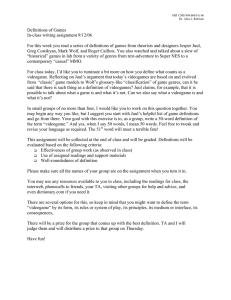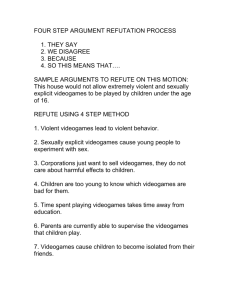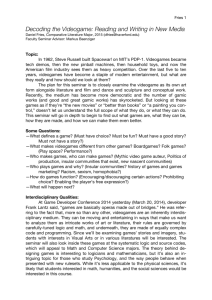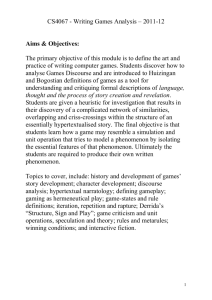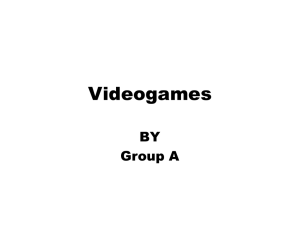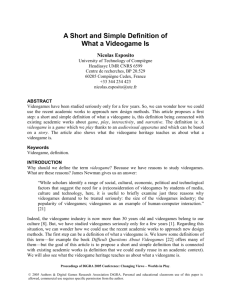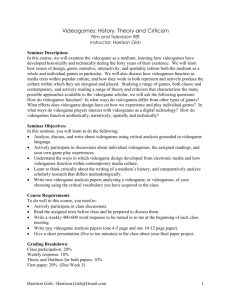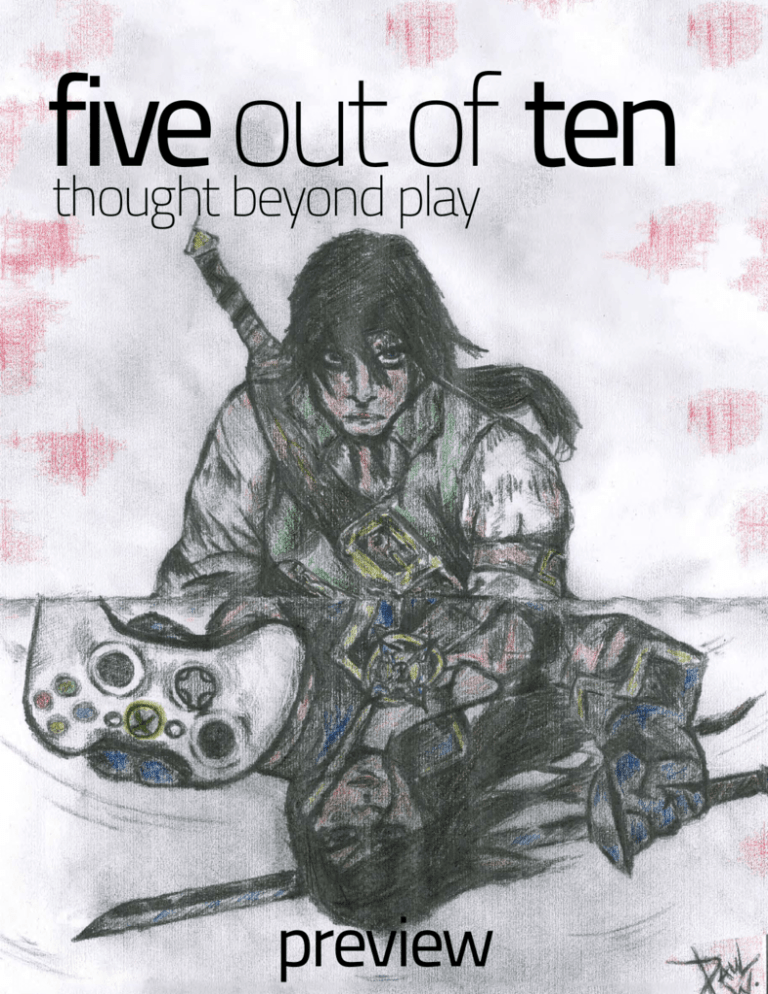
five
out
of
ten
thought beyond play
preview
reflect
Digital publishing is not a zero-sum game. As we lament the
passing of longstanding institutions like Game Developer, 1UP.
com, Gamespy and beloved publisher Lucasarts, we can take
heart that new developers and media are arriving to take their
place: some like the magazine you’re reading right now, some
funded independently through Kickstarter and other ventures.
There is enough room for all of us to grow.
Yet journalism as a profession is less secure than before.
Websites are reliant on diminishing advertising revenue and
breaking news quickly at the expense of in-depth reporting.
Journalists lack permanent contracts and are under increasing pressure to write for less, or even free. That’s why your
support for Five out of Ten is so important: our readers allow
our contributors to keep writing not just for us, but other outlets
as well. We’re proud to be part of this community.
We value your comments and criticism! If you’d like to email the
team or write a piece in response to one of our features, let us
know through the website and we’ll publish it in the next issue.
Thank you for supporting Five out of Ten.
Alan Williamson
Editor-in-Chief of Five out of Ten, co-founder of Split Screen,
writes for the New Statesman and Critical Distance. Originally
from Northern Ireland, he now lives in Oxford. His taste in
music is impressively varied and impressively terrible.
five
out of
ten
#3: Reflecting Reality
Editor-in-Chief: Alan Williamson Design Editor: Craig Wilson
Copy Editor: Robbie Pickles Tech Wizard: Marko Jung
Special Thanks: Joanna Stoneham, Paul Williamson
Email: editor@fiveoutoftenmagazine.com
Twitter, Facebook: @fiveoutoftenmag
contributors
Cameron Kunzelman
Nonhuman. He tweets @ckunzelman, blogs at This Cage is
Worms and makes games at heylookatmygames.com.
Robbie Pickles
History and Politics graduate working at the University of
Oxford whose pop culture references dry up around 1997. His
previous works include a comment on the Guardian website
and a terse quote in his high school magazine.
Jordan Erica Webber
Freelancer who writes and talks about games for the Observer,
PC Gamer, GamesTM, Family Gamer TV, IGN, and more. She
studied Philosophy and Psychology, and also likes other P
words like poetry and planets.
Craig Wilson
An assistant project manager with delusions of grandeur,
as well as the co-founder of Split Screen (unrelated). He
is a design consultant on Five out of Ten, produces lovely
infographs and doesn’t play many games.
Cover image: Paul Williamson
© 2013-2014 Five out of Ten. All rights reserved. Reproduction in whole
or in part without explicit permission is prohibited. Products named in
these pages are trade names, or trademarks, of their
respective companies.
http://www.fiveoutoftenmagazine.com
3-MIRRORSEDGE-REMASTER
contents
Personal Computing
5
Second Hand Memories
9
The evolution of PC gaming has alienated one lifelong player.
A ‘second-hand’ relationship with games can be more enlightening than a first-hand one.
Patricia Tannis, Asperger, and Me
14
Audio, Video, Disco
20
All The Mistakes I’ve Made
26
Blood, Births, and Backsides
34
Yokosuka, 1986
41
The Documents of War
46
Kill The Pig
53
The Stage of History
58
Is Borderlands 2’s Tannis a charicature of Asperger’s
disorder, or a way to help us understand it?
By emphasising visual effects, we have lost sight – or should that be
lost hearing? – of the power of sound to affect and excite us.
An infographic analysis on the diminishing appeal of infographics.
If games are meant to provide escapist fantasy, what draws
us to real-world simulations like The Sims?
Exploring how the pedantic realism of Shenmue draws us deeper into its fiction.
How do videogames contribute to the documentation of war
and its culture, and are the effects desirable?
A traumatic experience in Minecraft leads to a crisis of vegetarian faith.
Videogames play loose with the historical record. What’s
more important: accuracy, or authenticity?
Personal Computing
Robbie Pickles
FooT Header Setup/Article Installation Program
(C) Copyright 2013, Five Out of Ten, Inc
*
*
*
*
_
Y (,)
+( : )
|( : )
*
*
*
*
H
oping to avoid an unseasonal snowstorm, I went into the Oxford branch of Game
today. Game is Britain’s leading videogame store and, in the British retail
tradition, fails to make any profit despite its near monopoly on the high street.
When I was younger, every shopping trip would involve a visit to Game. I would
gaze in wonder at the latest titles, none of which I could afford. The years
have taken their toll on this experience and in 2013, entering Game has become
depressing to say the least.
>Given my aversion to this ghastly
retail experience, it took some
pretty inclement weather to force me
through the doors. Nowadays, there’s
a constantly diminishing selection
of PC games, which also seem to be
moving deeper and deeper into the
bowels of the store. Merely browsing
these titles seems to lend one an
air of guilt or desperation; how I
would imagine it feels to casually
peruse the top-shelf material in a
newsagent’s while a child is browsing
the comics. People around the store
dart a pitying glance in my direction.
Meanwhile, mainstream supermarkets
have ceased to stock any PC games
at all. Next to the MAIN PC section
in Game, there’s a separate PC Games
shelf that remains popular. It’s the
upmarket retail store equivalent of a
bargain bin, hawking two retro games
for £10: COMMAND AND CONQUER: RED
ALERT; ROME: TOTAL WAR; SIM CITY 2000.
>If anyone were to call me a gamer
at all, they’d probably call me a
PC gamer. Videogames fulfil a same
role in my life as reading books or
watching films: they’re fun, but I’m
not so invested that I would be worthy
of the moniker HARDCORE GAMER. The PC
has always been my choice of gaming
platform because I’ve always had one
in my house: games consoles are a
luxury purchase compared to an allpurpose family computer.
>Anyway, back to the bargain bin. I
spotted two games from the now-defunct
BULLFROG
PRODUCTIONS,
seemingly
evergreen: THEME HOSPITAL and DUNGEON
KEEPER 2. Stumbling upon these two
childhood gaming staples, the snow
still falling thick and fast, I had time
to reflect on my changing experience of
games and how few titles since these
classics have seemed as fun or as
engaging.
C:>QUANTUM>FOOT>3_REFLECTING_REALITY>ARTICLES>_
1 Help2 Menu3 View4 Edit5 Copy6 MkDir7 Delete
8 Quit
T
he following is a series of anecdotes that, I hope, will come
together to create a portrait of my early life and its relationship to video games. It is more likely it will fall apart and you’ll
be left with something like the glitter of history fading in your
hands. I’ll look like a fool and you’ll close the magazine in
disgust and confusion.
So here’s hoping that doesn’t happen.
Second Hand Memory, 2013
Cameron Kunzelman (b. 19XX)
Mixed Media
PlayStation Console &
DuelShock Controller, 1994
Sony Computer Entertainment (b. 1993)
Original grey SCPH-1000
T
I
he PlayStation 2 was released in the latter half
of the year 2000 to crowds of screaming teenagers who fainted at the very sight of its sleek and
boxy black plastic shell. If you are familiar with
these stories of the nostalgia-ridden childhoods
of games writers, this is the point where I would
usually explain that I spent a summer’s worth of
lawn mower money to get one on launch day from
a now-dead electronics retailer.
Or instead, in a parallel universe, I would wait a
couple of months and the PS2 would be waiting
under the tree with a game that I would subsequently write a thousand words about. The game
illuminates me: I build a machine from memories
and you fall in love with what it produces as much
as I have.
But my story about games and how they shaped
me takes place in the shadow of that well-worn and
loved narrative. It isn’t about getting and having
and participating in the revolution of videogames
as it occurred at the time. Instead, my childhood
was shaped by knowing that amazing, brilliant
things were happening in the design and scope of
videogames and being acutely aware that those
things were not happening to me.
I came into possession of a PlayStation because
someone else didn’t want it anymore. One day I
went to my aunt’s house and her shitty boyfriend
had moved or was moving or didn’t want it
anymore or something of that sort; at the end of
it, I went home with a small box that contained a
console, a controller, the requisite cords, and a
single game.
That game was some NASCAR shovelware that, I
am sure, is someone’s favorite piece of American
heartland racing memorabilia. I was a kid raised
on fantasy and science fiction and mysteries and
horror stories and The X-Files and Lego Magazine
and my dad’s Dungeons and Dragons modules
from when he was in high school. I didn’t have
time for car racing. I wanted to dodge around with
swords and shields while shooting lasers out of my
eyes in order to burn spacedemons into a crisp. I
wanted a power fantasy, and champagne popping
and outsized trophies weren’t really a part of that.
So I wanted out.
255
Pervasive Developmental Disorders
● 299.80 Asperger’s Disorder
A. Qualitative impairment in social interaction, as manifested by at least two of
the following:
(1) marked impairment in the use of multiple nonverbal behaviors such as eyeto-eye gaze, facial expression, body postures, and gestures to regulate social
interaction
(2) failure to develop peer relationships appropriate to developmental level
(3) a lack of spontaneous seeking to share enjoyment, interests, or achievements with other people (e.g., by a lack of showing, bringing, or pointing out
objects of interest to other people)
(4) lack of social or emotional reciprocity
B. Restricted repetitive and stereotyped patterns of behavior, interests, and activities, as manifested by at least one of the following:
(1) encompassing preoccupation with one or more stereotyped and restricted
patterns of interest that is abnormal either in intensity or focus
(2) apparently inflexible adherence to specific, nonfunctional routines or rituals
(3) stereotyped and repetitive motor mannerisms (e.g., hand or finger flapping
or twisting, or complex whole-body movements)
(4) persistent preoccupation with parts of objects
C. The disturbance causes clinically significant impairment in social, occupational, or other important areas of functioning.
D. There is no clinically significant impairment in social, occupational, or other
important areas of functioning.
E. There is no clinically significant delay in cognitive development or in the
development of age-appropriate self-help skills, adaptive behavior (other than
in social interaction), and curiosity about the environment in childhood.
F. Criteria are not met for another specific Pervasive Developmental Disorder
or Schizophrenia.
Diagnostic and Statistical Manual of Mental Disorders, Fourth Edition.
Copyright 1994 American Psychiatric Association
Pervasive Developmental Disorders
256
Patricia
Tannis,
Asperger,
and Me
Jordan Erica Webber
“Psycho bitch.”
A
friend and I are playing Borderlands 2, and because this is cooperative and not competitive
play we’re using our headsets to abuse the characters rather than each other. In this case, we’re
undertaking missions for Patricia Tannis, whom
we hate because her mental instability caused her
to betray us in the previous game. She deals out
our next task with a typically psychotic comment,
and the mission description itself – which doesn’t
come from her – reads:
“How did an insane introvert with
Asperger’s manage to survive in Sanctuary?”
My body reacts like I’ve seen a horrible accident
too far away to intervene.
“Did you see that?” I demand, but unlike me my
friend does not feel compelled to read every word
of every description for every mission, and probably doesn’t even remember the time when we
were still teenagers and I came out of the mental
closet. Besides, I have to get my head back in the
game; forget the anxious sickness pooling in my
belly, there are bandits to be killed.
Fig. 1 Patricia Tannis
Like walking in on a scene you didn’t want to witness, or suddenly remembering something you
wish you could forget, this sickness creeps up on
me from time to time. I felt it when one of my lecturers said that my pencil sketch looked like the
handiwork of an idiot savant, and when I told him
the truth he said:
“Explains a lot.”
I felt it when my partner suggested we watch Rain
Man, a film about a man who actually is a savant
and also happens to be autistic. My partner knows
more about me than anyone does, but I worried
that he thought this would help him to learn more.
M
usic is the most wonderful medium of human culture. If I had to choose
between music and games, music would win every time: nothing
else can elicit the same emotions, whether I’m at a rock festival with fifty
thousand people or terrified by pop recluse Scott Walker’s latest explorations of the macabre. Nothing else can capture the entirety of experience,
the richness of life.
When it comes to videogames, there’s a clue in the very name as to where
technology has focused. But by emphasising graphics at the expense of
audio, game developers have lost sight - or should that be lost hearing? - of
the power of sound to affect and excite us. If you read the latest technology
news, it’s easy to assume that progress is measured squarely by the pixel:
the recent PlayStation 4 announcement focused on its horsepower, while
Apple’s latest iPad promises twice the visual fidelity of the last model as if
that was actually quantifiable by the human eye. The new Xbox will probably forego your television altogether, using a modified Kinect camera to
burn images directly onto your retinas.
Yet for all the talk of the iPad’s ‘Retina Display’, ten-point touch screen and
gyroscope, it still has a single tinny speaker. The Nintendo 3DS has two
weedy stereo speakers that barely perforate the surface plastic. Meanwhile,
the thinner modern TVs get, the worse they sound! Information is beamed
straight at the front of your face, ignoring other senses. If you tilt the 3DS
at an angle, its illusion of magic is immediately and startlingly broken.
Graphics are ever-improving; sound is merely ‘good enough’.
Audio, Video, Disco
Alan Williamson
E
ven someone completely ignorant of videogames is probably familiar with the jingles of
Pac Man or the main theme of Super Mario Bros.
Early game composers had to be economic with
their use of instrumentation, since resources were
highly constrained. The Nintendo Entertainment
System had five sound channels: two pulse waves
typically used for melodies, a triangle wave often
used for basslines, a noise channel for percussive
effects, and a all-purpose sample channel. As with
many creative endeavours, an apparent lack of
versatility allowed a paradoxically massive variety
of NES tunes whose melodies have stood the test
of time: Castlevania, Mega Man, Final Fantasy
to name just a few. Beyond game soundtracks,
artists such as Beck, The Postal Service and Crystal Castles continue to use old hardware like the
Nintendo Game Boy and Commodore 64’s SID
sound chip. While bands like Anamanaguchi have
fused ‘chiptune’ music with indie rock, new styles
of electronic music such as dubstep have been
influenced by Yuzo Koshiro’s Streets of Rage 3
soundtrack.
Sound technology developed rapidly through
the 90s: pseudo-orchestral game soundtracks
became possible with the Super Nintendo and
MIDI sequencing sound cards for home computers.
The Sony Playstation and Sega Saturn introduced
CD-quality sound, although this came with the
unfortunate prevalence of synthesised instruments. They sounded alright at the time, but now
Castlevania II: Simon’s Quest (1988)
they’re like something you’d hear on a pound shop
relaxation CD. Around the turn of the millennium,
sound processing reached a ‘good enough’ state
with few real limits on the quality of sound. Larger
game budgets led to full orchestral recordings
and licensed soundtracks. Modern consoles and
PCs support digital audio, multi-channel surround
sound and all kinds of technical stuff I don’t want
to write about and you don’t want to read.
The critic Peter Hassleström focuses on the soundscapes of videogames. He cites Metro 2033 as
one of a growing number of games where sound
isn’t just a backing track, but an integral part of
the atmosphere. It uses ‘wave tracing’ to simulate
sounds echoing off structures in the environment,
transforming obviously fake effects into something much more convincing to our ears. Ultimately,
wave tracing provides the same window dressing
as fancier lighting effects as game developers
chase an unreachable goal of rendering reality. But
what if music can be more than aesthetic - what
if music is the game?
How to Revolutionise the World of
(Amateur) Videogame Blogging
How to Make Viral Posts/Money/Friends
a Wordpress Account
How to be Popular/Successful/Happy
Writing about Videogames
Top Ten Videogame Blog Posts
1. Know The Competition
GameAlmighty GameAxis GameBlitz GameBoomers GameBoyStation
GameBoyz GameBus it’s GameCell GameCenter GameCheap
GameChronicles GameCritics GameDaily GameFan GameFAQs GameFocus
GameFocus GameFront difficult GameGlobe GameguruMania
GameHelper GameIndustryNews
GameInformer
GameNow
GameOverOnline GamePen GamePlanet to GamePlasma GamePlayer
GamePolitics GamePositive GamePower GamePro GameRaiders
GameRankings GameRanx GameRevolution be GamesDomain GamesBeat
GamesFirst GamesLife GamesRadar GameSpot GameSpy GamesTM
GameTrailers GameVortex different GameWank GameXC GameZebo
GameZombie GameZone AdventureGamers AtomicGamer AusGamers
AussieGamer when AverageGamer ChristcenteredGamer CPUGamer
CriticalGamer DroidGamers EuroGamer ExtremeGamer GayGamer
GirlGamer HardcoreGamer everyone’s HonestGamers ImpulseGamer
IndependentGamer IrateGamer MadGamers MyGamer NintendoGamer
NewGamer NowGamer NZGamer totally OpinionatedGamers
OriginalGamer PCGamer PocketGamer RealGamer unique RetroGamer
RPGGamer SarcasticGamer TreadmillGamer VideoGamer YouGamers
“W
elcome to the world of enthusiast videogame blogging”, they said. “A proud
pastime akin to throwing bricks in the wind.
First things first, let’s see who you’re competing
against for those delicious readers”.
So I needed to be different: I won’t do news
(rewritten press releases), I won’t do previews
(lists to Santa), my reviews will be critical (but not
unwieldy yet still satisfy consumer needs). I won’t
do what the others do.
It continues to be exhausting shouting above the
noise. So many voices all crying out to be your
one-stop shop for all things game. Each writing
in a vacuum pretending to some extent that the
others don’t exist.
Just like everyone else.
I needed to find a unique style to set myself apart
from the competition. Something totally unique.
reflecting
reality
The videogame industry has focused on increasing levels
of realism through new generations of technology. The
ultimate goal seems to be a reflection of reality, with photorealistic mountains and uncanny valleys. Yet reality is more
complex than that. As Morpheus said in the science-fiction
classic The Matrix:
“What is real? How do you define real? If you’re talking about
what you can feel, what you can smell, what you can taste
and see, then real is simply electrical signals interpreted by
your brain.”
We hear of games becoming ever more realistic, but maybe
they’re just becoming more intricate fantasies. There’s a
place in gaming for both documentary and drama, fact
and fiction. In this issue, we look at how games interpret
our environments and influence our culture.
Welcome to the real world.
Blood, Births and
Backsides
Jordan Erica Webber
I
n one of my favourite games you have to clean
toilets, recycle old newspapers, and pay the bills
on time. As the actions I’ve queued up for my
obedient Sim disappear one by one across the
top of the monitor, my own to-do list increases
with the unstoppable tide of time and emails. The
impractical truth is that I’d rather wash a hundred
virtual dishes than the few stacked next to my
real-world sink.
With their penchant for handing over power, generally in the form of a sword or a gun, videogames
have a reputation as a mode of escapist fantasy.
So the notion that players want realism looks like
a contradiction; surely the further from reality you
are able to go, the easier you’ll forget your realworld troubles? Surely I’d rather play a game that
bore no resemblance to my real life, dirty dishes
and all?
Yokosuka, 1986
Yokosuka, 1986
Alan Williamson
I
t snowed on November 29th 1986 in Yokosuka.
More a light frosting than a blizzard, just enough
to form in patches around the cherry trees. Meanwhile, Cary Grant died. British police searched
for two newly identified Moors Murders victims,
twenty years after the killers’ original conviction.
I don’t remember any of these events of course,
as I was two months old. I can only piece things
together through Wikipedia and, in the case of
Yokosuka, Sega’s masterpiece Shenmue.
Shenmue is a game that pushes the limits of
pedantic realism. It has the correct weather forecast for that region of Japan in 1986, simulated
day to night transitions, a town full of people who
have their own lives and behavioural patterns.
The gratuitous attention to detail - even individual
drawers in a chest can be opened and the pixellated contents perused - and protracted development cycle, which initially targeted the Sega
Saturn before migrating to the Dreamcast, took
an obvious financial toll on the company. With
an estimated cost of $70 million, it was the most
expensive videogame ever made when released
for the Dreamcast in 1999, and still makes the
top five today.
All that money didn’t go to waste: although a
decade is a lifetime in technology, Shenmue
remains an impressively authentic portrayal of
the Eighties. I’ve often felt that the Dreamcast
marks the point when audiovisual technology
became suitably nuanced and characters stopped
looking like painted cardboard boxes with limbs
attached on hinges. Developers could unleash
their full creative potential: the Dreamcast in
particular was host to some of gaming’s most
abstract titles including Jet Set Radio and Rez, a
design trend that is now in resurgence as new
generations of hardware lead to ever-diminishing
aesthetic returns.
Documents of War
Craig Wilson
I
see a warship from my office window. I think
about the warship often. How it’s built, about
the plan, what the current issue is and what we
need to do in order to finish the job. That’s my job.
I don’t think about war. I don’t think about this
platform - this giant, floating, deadly piece of metal
- operating in and swiftly ending conflict. I’m just a
gear building another gear of war. I build the platform, the military use the platform. To my mind war
and conflict, defence and peace, only truly exist in
the hands of governments and their military. Yet
put a controller in my hand, and a videogame on
the screen, and I’ll tell you that I do think about war.
The Imperial War Museum in London chronicles
the history and experience of war across its multiple floors. For all the varied artefacts - weapons,
maps, film, posters, music, letters, bric-a-brac there are no videogames on display. What can
games contribute as documents of war?
The lower floors house permanent galleries on the
First and Second World Wars. Displayed around the
replica trenches, the plastic wet mud lit by lamplight, are the khaki-costumed mannequins of Tom,
Dick and Harry fighting for King, country and the
ladies back home.
The romanticism of the Great Wars has never sat
well with me. There is a certainty to the old wars
that we’ve applied retrospectively. We now have
the political and social narrative to the past wars to
make sense of it. We’ve derived this narrative from
the dissemination of the vast wealth of information captured in that era: military records, soldier
accounts, newspapers and stories from the public.
Maybe I’ve just heard the stories too many times
but I struggle to hear past what, at its worst, is
jingoistic lip service.
Kill the Pig
Kill the Pig
Cameron Kunzelman
I
killed a pig in Minecraft. That doesn’t seem like
a big deal. Maybe it isn’t a big deal. I don’t know.
I have to tell a story to get us all on the same page.
Here is that story.
I started playing Minecraft during winter break
from college in 2010. My schedule during that
month went something like this: wake up, go into
my spare room, turn on my computer, start World
of Warcraft then play for several hours until my
partner was imminently returning home from work.
Then I would rush to take a shower and present
myself as if I had been doing something that wasn’t
a massive waste of time for hours on end.
Like most people who play World of Warcraft, I
had a small group of friends who I would play with.
We knew one another in real life. We all lived on
the same coast of the United States. None of us
had much going on in our lives other than simply
going through the motions of school-play-sleep,
work-play-sleep, sleep-play-sleep, or other variations on that theme. We were predictable. We
were filling time.
The Stage of History
Robbie Pickles
T
hey may take our lives, but they’ll never take
our freedom! yells Mel Gibson at the culmination of the most poorly judged pre-battle speech
ever to come out of Paramount Studios.
Garbed in an anachronistic tartan kilt, and inexplicably coated in blue ‘woad’ paint, Gibson portrays
the legendary Scottish hero William Wallace in
the Hollywood epic Braveheart. His battle cry is
not only spectacularly uninspiring – what use is
freedom when an English mercenary is ripping the
boots from your corpse? – but the average Scottish
clansman of the 13th century would know little
of freedom or, indeed, how the English may or
may not have impinged upon it. Only the wealthy,
with a stake in the lifeblood of their estates, would
heed such a cry.
For the fictional William Wallace, dramatized in
poetry long before the silver screen, was not much
of a freedom fighter in reality. Instead like his spiritual brother Owain Glyndŵr, flag bearer for the
Welsh nationalism movement, he was one of many
dispossessed landlords with plenty of reason to
despise the English. His crusade for justice during
the ‘Great Cause’ had little to do with the freedom
of the spirit of a nation, when the concept of shared
national culture was in its infancy.
five
out
of
ten
thought beyond play
year one:
reloaded
Remastered. Reloaded.
1: New Horizons
November 2012
2: Players Guide
February 2013
3: Reflecting Reality
April 2013
4: Storytellers
July 2013
5: Mind Games
September 2013
Get it from http://www.fiveoutoftenmagazine.com

